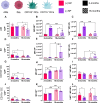Age-dependent changes in phagocytic activity: in vivo response of mouse pulmonary antigen presenting cells to direct lung delivery of charged PEGDA nanoparticles
- PMID: 39135064
- PMCID: PMC11318229
- DOI: 10.1186/s12951-024-02743-7
Age-dependent changes in phagocytic activity: in vivo response of mouse pulmonary antigen presenting cells to direct lung delivery of charged PEGDA nanoparticles
Erratum in
-
Correction: Age-dependent changes in phagocytic activity: in vivo response of mouse pulmonary antigen presenting cells to direct lung delivery of charged PEGDA nanoparticles.J Nanobiotechnology. 2024 Dec 12;22(1):751. doi: 10.1186/s12951-024-03040-z. J Nanobiotechnology. 2024. PMID: 39663532 Free PMC article. No abstract available.
Abstract
Background: Current needle-based vaccination for respiratory viruses is ineffective at producing sufficient, long-lasting local immunity in the elderly. Direct pulmonary delivery to the resident local pulmonary immune cells can create long-term mucosal responses. However, criteria for drug vehicle design rules that can overcome age-specific changes in immune cell functions have yet to be established.
Results: Here, in vivo charge-based nanoparticle (NP) uptake was compared in mice of two age groups (2- and 16-months) within the four notable pulmonary antigen presenting cell (APC) populations: alveolar macrophages (AM), interstitial macrophages (IM), CD103+ dendritic cells (DCs), and CD11b+ DCs. Both macrophage populations exhibited preferential uptake of anionic nanoparticles but showed inverse rates of phagocytosis between the AM and IM populations across age. DC populations demonstrated preferential uptake of cationic nanoparticles, which remarkably did not significantly change in the aged group. Further characterization of cell phenotypes post-NP internalization demonstrated unique surface marker expression and activation levels for each APC population, showcasing heightened DC inflammatory response to NP delivery in the aged group.
Conclusion: The age of mice demonstrated significant preferences in the charge-based NP uptake in APCs that differed greatly between macrophages and DCs. Carefully balance of the targeting and activation of specific types of pulmonary APCs will be critical to produce efficient, age-based vaccines for the growing elderly population.
Keywords: Aging; Antigen presenting cells; Nanoparticles; Phagocytosis; Pulmonary delivery; Pulmonary immunity.
© 2024. The Author(s).
Conflict of interest statement
The authors declare no competing interests.
Figures







Similar articles
-
Nanoparticle surface charge impacts distribution, uptake and lymph node trafficking by pulmonary antigen-presenting cells.Nanomedicine. 2016 Apr;12(3):677-687. doi: 10.1016/j.nano.2015.11.002. Epub 2015 Dec 1. Nanomedicine. 2016. PMID: 26656533 Free PMC article.
-
The TLR5 Agonist Flagellin Shapes Phenotypical and Functional Activation of Lung Mucosal Antigen Presenting Cells in Neonatal Mice.Front Immunol. 2020 Feb 18;11:171. doi: 10.3389/fimmu.2020.00171. eCollection 2020. Front Immunol. 2020. PMID: 32132997 Free PMC article.
-
Differential uptake of nanoparticles and microparticles by pulmonary APC subsets induces discrete immunological imprints.J Immunol. 2013 Nov 15;191(10):5278-90. doi: 10.4049/jimmunol.1203131. Epub 2013 Oct 11. J Immunol. 2013. PMID: 24123688
-
Interaction of biomedical nanoparticles with the pulmonary immune system.J Nanobiotechnology. 2017 Jan 9;15(1):6. doi: 10.1186/s12951-016-0242-5. J Nanobiotechnology. 2017. PMID: 28069025 Free PMC article. Review.
-
Antigen presenting cell-selective drug delivery by glycan-decorated nanocarriers.Eur J Pharm Biopharm. 2015 Sep;95(Pt A):13-7. doi: 10.1016/j.ejpb.2015.02.008. Epub 2015 Feb 19. Eur J Pharm Biopharm. 2015. PMID: 25701806 Review.
Cited by
-
Nanoparticle-Based Pulmonary Immune Engineering.Annu Rev Chem Biomol Eng. 2025 Jun;16(1):249-270. doi: 10.1146/annurev-chembioeng-082223-105117. Epub 2025 Mar 12. Annu Rev Chem Biomol Eng. 2025. PMID: 40073112 Free PMC article. Review.
References
-
- Skloot GS. The effects of Aging on Lung structure and function. Clin Geriatr Med. 2017;33:447–57. - PubMed
MeSH terms
Substances
Grants and funding
LinkOut - more resources
Full Text Sources
Research Materials
Miscellaneous

